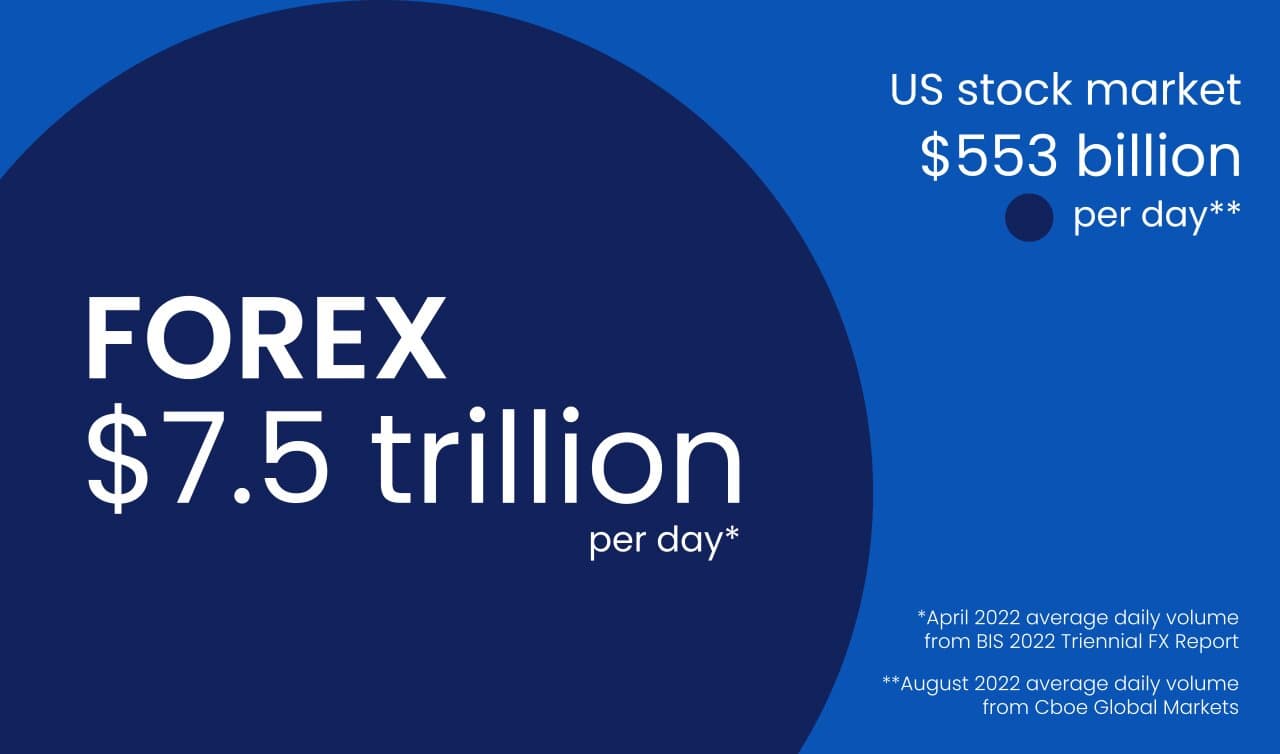Mastering forex
Forex vs stocks
Whether you are a complete novice or actually understand quite a lot about trading, it is really important to have a clear mind when it comes to getting to grips with the mechanics of your trades.
The financial markets can often seem overwhelming to a first-timer, so it’s important to educate yourself about the different trading instruments. If you read the right content and watch useful webinars – and by the way we have lots of material on demand to guide you right here at FOREX.com – then you can become much more confident about trading.
This article will look at some of the comparisons between forex - otherwise known as currency trading, the foreign exchange market or sometimes simply FX – and stocks, the shares into which ownership of a particular corporation is divided and which are also tradable instruments.
- What’s the difference between forex and stocks?
- Forex: High liquidity can mean easy access and narrow spreads
- Trading 24/5: The forex markets are always moving
- Leverage: The ability to trade deeper within a market
- The mechanics: Understanding the basics of forex
What’s the difference between forex and stocks?
Although there are many differences between trading currencies and stocks and each has its own benefits and drawbacks, below are some of the factors you should consider:
When trading forex, each trade you make will focus on a single currency pair. It may be EUR/USD, USD/JPY, USD/CAD or AUD/USD – these are some of the more popular pairs. Alternatively, you might be interested in trading the Swiss franc, the Chinese renminbi or the Hong Kong dollar against the US dollar or other currencies.
FOREX.com offers more than 80 currency pairs. When making a trade you will always be either buying or selling the first named currency in the quoted currency pair. A trader who buys euros in the EUR/USD market believes the euro is set to perform better relative to the dollar; a trader who sells in this market believes the opposite will be the case.
As for stocks, traders can elect to buy equity in any company whose stock price they believe has scope to rise. There are also additional instruments, known as derivatives, which include options and futures. These offer greater flexibility and are usually suitable for experienced or institutional traders aware of the additional risks involved and how to manage those risks.
When trading stocks in the traditional sense you must first buy shares before you can sell them; with certain types of derivatives a trader who forecasts that a company’s stock is headed downwards can get involved immediately in “shorting” the stock without prior ownership of it.
With its high liquidity and 24-hour-a-day (Sunday 5PM EST to Friday 5PM EST) trading opportunities during market hours, forex offers traders plenty of scope to buy or sell within individual currency pairs, and without requiring access to derivatives.
Forex: High liquidity can mean easy access and narrow spreads

Due to the sheer scale of the FX market, with 7.5 trillion dollars traded every day, high liquidity is one of the most consistently appealing factors.
Usually when liquidity is high, you have what is termed a “tight” market, and spreads – the difference between the buy and sell prices - are low: this is a good thing for all traders but particularly short-term traders. Market liquidity can fluctuate throughout the day as different sessions open and close around the world and it varies greatly depending on the FX pair.
When it comes to stocks, liquidity is usually strong compared to many other asset classes. But like FX, not always. Some stocks typically trade more actively than others. The most liquid stocks are usually identifiable by their average daily volume, which can be in the millions, or even hundreds of millions, of shares.
By contrast, others are traded far less actively, and if you are looking to exit a position in a stock that lacks liquidity it can be tricky to make a cost-effective trade in a timely manner.
Many traders who have not discovered the unique attractions of trading forex, on the other hand, will be pleasantly surprised to discover just how easy it is to enter and exit a market when trading in the major currency pairs during times of increased liquidity.
Trading 24/5: The forex markets are always moving
If you are trading stocks, then you are beholden to conduct your business within the hours of the relevant stock exchange on which each company is listed. For example, the New York Stock Exchange operates a core trading session between 9.30am and 4pm Eastern Time.
However, increasingly extended hours are being offered to traders through relevant derivative markets.
One major benefit of including forex within your strategy is its customer-friendly round-the-clock nature. They’re open as regularly as hypermarkets, from 5pm ET on Sunday (9am Monday in Sydney, Australia) until 5pm ET on Friday (when the market closes in New York).
While this is good news for many traders who want to see markets moving at times convenient to them, it is also a good idea to manage your positions by setting Take Profit and Stop Loss orders, especially when you are offline to help protect your trades from unnecessary losses.
Leverage: The ability to trade deeper within a market
At FOREX.com, we provide leverage to allow traders deeper access to markets. In essence, we are lending you capital to help multiply your buying power in a market and, once you are aware of the risk factors involved, it is an extremely valuable aspect to forex trading. However, traders should be aware that increased leverage increases risk.
Leverage is normally expressed as a ratio. For example, if your account has a leverage of 50:1, you have the ability to trade a position of $50,000 with only $1,000 of your own funds. In order to maintain your position while trading on leverage, a small amount of money, described as “margin”, is set aside in your account.
Leverage, which can also come into play when trading options and futures, is particularly popular within forex and facilitates efficient trading. However, it is essential traders maintain the minimum margin requirements for all open positions in order to avoid any unexpected liquidation of trading positions.
Whichever market you choose, its is important to be aware of the size of your exposure and understand the risks involved.
The mechanics: Understanding the basics of forex
If, after reading this, you think forex is for you, then you’ve come to the right place. With an account at FOREX.com you have the option of opening a risk-free demo account, and this is strongly advised for first-time traders.
This will allow you to get the feel of our industry-leading platform and see how leverage works. You will have the option of setting Take Profit and Stop Loss orders that allow you to manage your exposure to the market. And you can do all this without committing a cent of your own money. If you feel you need to learn more about how forex works, our user-friendly educational materials are always on hand. Once you feel confident, you can then open and fund a live account in just minutes.
At FOREX.com, our intention is to give you all the information you need to help you become a better traders. Read our daily analysis on the biggest trading pairs to get a strong grasp of potential price movements, access trading forums on social media and do everything you can to unravel the ins and outs of forex.

